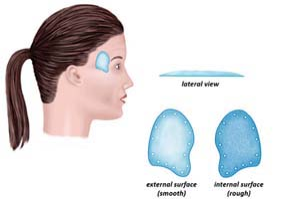Temporal Implants
“Although my preferred implant material is Porous Polyethylene, the Temporal Region is one area that I prefer to use Silicone materials. This is due to the soft-tissue composition of the Temporal Region. To correct this Hollowing or “wasting”, of the temporal area, I use a very specific endoscopic technique resulting in hidden scars (within the hairline).”
The temporal implant is made of a soft rubber silicone of a low or medium elastomere. The thickest portion of the implant corresponds to the glabrous portion of the temporal skin. The inferior and anterior borders are irregularly curvilinear and correspond to the silhouette of the temple and conformed by the zygomatic arch, outer border of the external orbital rim and temporal line of fusion. All borders taper down to 1 mm thickness to prevent visibility or palpability. The core of the implant has various degrees of thickness and size. The superficial surface is smooth and the deep surface is usually rough to aid in its stability. Thee implant has several minute perforations along its borders to allow suturing to the temporal fascia or periostium at its peripheral boundaries. The implant is placed in between the superficial and deep temporal fasciae. This space is developed thru small incisions (2 cm) in cases of endoscopic techniques or larger incisions in cases of open techniques. The implant is folded on itself during its introduction. It is secured with several 4-0 polydioxanone sutures. No drains are usually needed but a mildly compressive bandage is beneficial.
The implant has been used in twelve temples (six patients, all with bilateral defects). Endoscopic techniques were used in 5 patients and the open method in one. One patient developed postoperative unilateral hematoma treated with a single percutaneous aspiration. There has been no other complication. No palpability or visibility of the implants was noticed. The aesthetic correction was considered excellent in all patients.
A new implant design and a new surgical procedure to correct a concavity or flattening of the temporal area seem to be an excellent option to correct this structural or involutional defect of the temporal area. It provides an impressive aesthetic improvement in this area.

